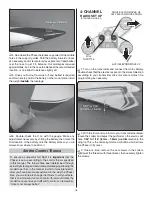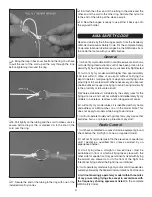
24
Flying
Simply stated, the Phazer is a “hoot” to fl y! It sounds pretty
cool, looks
quirky
and
cute
in the air and is actually quite docile
even though it’s pretty fast. But delta-wing airframes do have
a few peculiarities that you should anticipate. The Phazer is
unusually stable and will not stall and spin from turning too
sharply, but it does bleed off speed in tight turns—if you turn
too
tightly for
too
long it will bleed off enough airspeed to lose
signifi cant altitude or the nose may rotate downward, so just
fl y it “large” for the fi rst minute until you get used to it. And
same as any jet, more time and distance are required to get
the Phazer back up to speed after throttling up, so you have
to fl y “ahead” of it some.
Those two concepts in mind, once airborne the primary
objective will be to get the Phazer trimmed for straight-and-
level fl ight. It’s not so fast that you won’t be able to fl y it full
throttle, but fl y it around at whatever speed you are comfortable
with while you are getting it trimmed. Also test how the Phazer
responds on high and low rates (but you’ll probably end up
fl ying it on high rates most of the time). Try some rolls, loops
and inverted fl ight. If you fi nd the nose of the Phazer yawing
downward in turns, the C.G. may be too far forward. Try moving
the C.G. aft.
Landing
While at altitude and still with plenty of battery power, simulate
a few landing approaches by cutting the throttle and watching
how the Phazer glides. Then throttle up, go around and try
it again. You might notice that the Phazer bleeds off speed
a little faster than you expected. Knowing this you can make
your approaches a little shorter, or simply “drag” it in with some
throttle. If you end up coming in hot simply throttle up, fl y by
and go around again. When the Phazer does touch down it
safely glides along the grass before coming to a quick stop.
After every landing inspect the intake, fan and exhaust tube
and remove any grass or debris—and don’t forget to note
how long you fl ew on that battery so you can start calculating
your own fl ight times!
One fi nal note about fl ying your Phazer. Have a goal or fl ight
plan in mind for
every
fl ight. This can be learning a new
maneuver(s), improving a maneuver(s) you already know,
or learning how the model behaves in certain conditions
(such as on high or low rates). This is not necessarily to
improve your skills (
though it is never a bad idea!)
, but more
importantly so you do not surprise yourself by impulsively
attempting a maneuver and suddenly fi nding that you’ve run
out of time, altitude or airspeed. Every maneuver should be
deliberate, not impulsive. For example, if you’re going to do a
loop, check your altitude, mind the wind direction (anticipating
rudder corrections that will be required to maintain heading),
remember to throttle back at the top, and make certain you
are on the desired rates (high/low rates). A fl ight plan greatly
reduces the chances of crashing your model just because
of poor planning and impulsive moves.
Remember to think.
Have a ball! But always stay in control
and fl y in a safe manner.
GOOD LUCK AND GREAT FLYING!
This model belongs to:
Name
Address
City
, State
, Zip
Phone Number
AMA Number
Aileron Horn Template

































